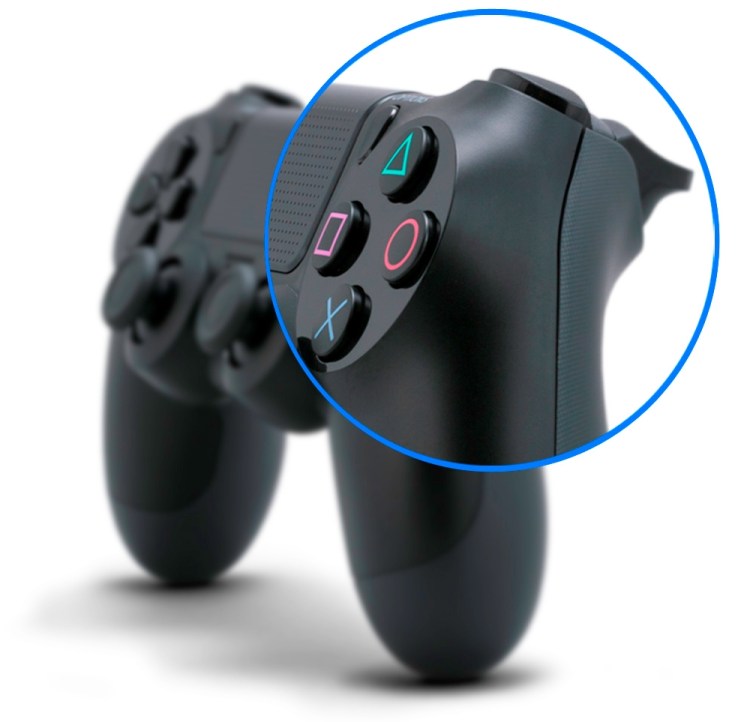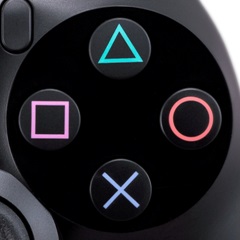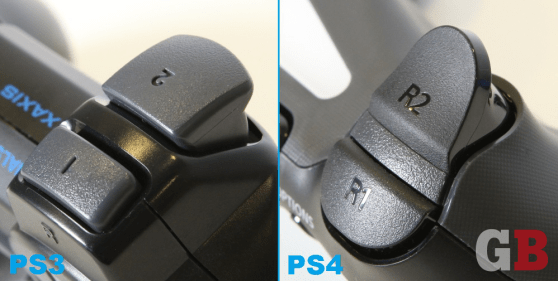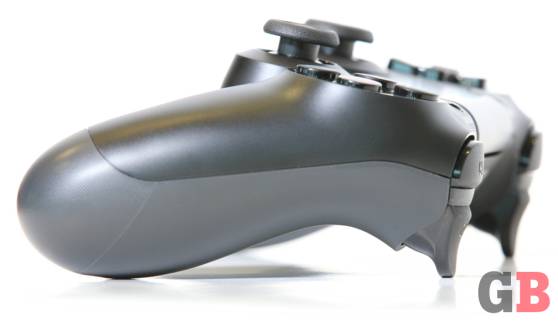This is part of our ongoing series about games and trends of the upcoming next generation. For the Xbox One version of this article, go here.
The PlayStation 4 controller:
- Part 1: The weird stuff that could’ve been
- Part 2: What’s new with the analog sticks and D-pad
- Part 3: What’s new with the buttons and triggers
- Part 4: A close look at the touchpad, light bar, and everything else
Today, with the help of some exclusive interviews, we take a very close look at the changes Sony made to the primary buttons on the new DualShock 4 controller for the upcoming PlayStation 4 console. The iconic face buttons — X, Square, Triangle, and Circle — haven’t changed much. But the shoulder keys have gone through a major redesign that should thrill most gamers when the system releases Nov. 15.
The face buttons
Let’s get this out of the way first: The face buttons on the DualShock 4 are fundamentally the same as they are on the PS3’s DualShock 3. Outside of Sony, those reading this article may be the only ones who can say what has changed. “A lot of people liked the feeling of the [DualShock 3’s] buttons,” said Toshimasa Aoki, the manager at Sony Computer Entertainment’s product planning department. “We made them as much the same as possible [for the DualShock 4]. I don’t think you would feel a difference.”
And no one’s changing the world-famous PlayStation symbols, either. “They’re so iconic,” said Tommy de Roos, the lead gameplay programmer for Guerrilla Games (makers of PS4 launch title Killzone: Shadow Fall and one of the studios that gave early input on the new controller). “There was a strong urge against changing that.”
The function:
Although the new face buttons feel the same, they don’t necessarily behave the same as their predecessors — again, not that many people will notice or even care. Older controllers can sense how hard or soft you’re pressing the front four buttons to provide a limited range of input, not just “on” or “off.” For example, maybe a firm, forceful push of the X would cause you to accelerate faster in a racing game than if you just lightly tapped it.
“With the DualShock 3, we were able to get analog data, which games didn’t really use,” said Aoki with a laugh. “For DualShock 4, we deleted that, and now it’s all digital. The mechanism inside is a little different, and the data that games get is different.”
The layout:
We bet you never knew that the DualShock 3 controller’s face buttons aren’t spaced equally apart: Square and Circle are just a teeny tiny bit farther apart than Triangle to X. No, seriously. Go take a look.
When Aoki pointed this out to us, we were a bit surprised. We never realized. “Nobody noticed it,” he told us. “Actually, when we were testing and laying it out, we said, ‘Hey, the DualShock 3 isn’t really the same distance there.'”
That’s changed on the DualShock 4, and the face buttons now form a perfect square. This tweak wasn’t just to appease some anal-retentive engineer at Sony. It’s to make a little room. “When we designed the DualShock 4,” said Aoki, “we wanted the touchpad to be in the middle and as large as possible but not enough to make the controller really big. We made the square and circle a little closer, so they’re the same distance as all the buttons. That saves horizontal space to have more for the touchpad.”
The shoulder buttons
While X, Square, Triangle, and Circle didn’t get their face-button-lifts, the four bumpers on the top of the controller went through some major changes, all for the much, much better. Starting with the most obvious … .
The shape:
The formerly bulbous shoulder buttons in the back row, L2 and R2, are now curved inward, making them trigger-shaped like on the Xbox 360 controller. Shooter fans should obviously be pleased. “The triggers feel a lot better now,” said Shadow Fall’s director, Steven ter Heide. “They feel a lot more natural.” So natural that the Killzone team has made R2 the “shoot” button for its upcoming PS4 outing, when traditionally it’s been R1 in this first-person-shooter series. (You can opt for either in the game’s settings.)
How they rest on a surface:
We’ve heard horror stories from Dark Souls players who have made huge mistakes in the unforgiving action role-playing world simply by setting the PS3 controller down. Because the L2 and R2 buttons are just so exposed and out there, resting them on the table or on your lap can depress them, causing, for example, your hero to take a huge swing of his sword and permanently kill an innocent but vital nonplayer character.
Of course, Dark Souls isn’t the only thing to have relationship issues with the shoulder buttons. “When we discussed what people hated about the DualShock 3, the very first thing was always that, when you put the controller down, it fast-forwards your Netflix,” said Aoki with a laugh.
The Xbox 360 controller avoids this problem by having some of its plastic back creep up underneath to envelop the bottom of the triggers, preventing them from touching a resting surface.
The PS4 controller doesn’t quite have that same level of protection for its L2 and R2 buttons, but it is an upgrade over the PS3. The bottoms of the triggers are level, so they rest squarely on flat surfaces. Unlike with the DualShock 3, if you set the DualShock 4 on your coffee table and push straight down on it, it won’t cause the L2 or R2 buttons to depress (we’ve tried). If you push it down and forward, however, you still have the potential to activate those triggers by accident (a little more than with the 360 controller since the tips here can catch on, say, the carpet more easily without that extra layer of plastic underneath).
The stroke:
Ever notice that the PS3’s L2/R2 are a bit squishy? “I don’t know how to describe them,” said Aoki of those buttons. “Rubberish? When you press the R2 on the DualShock 3, it has that mushy feel. Of course we wanted to fix that, but also keep [racing game Gran Turismo developer] Polyphony’s request of being able to get that linearity in the stroke.”
This means pulling on the DualShock 4’s triggers gives you a smooth resistance from start to finish. Overall, it feels slightly stiffer compared to the DualShock 3, too, but the consistency through the full range of motion is tangible and doesn’t feel like you’re pinching a rubber ball.
This, however, leads to other engineering considerations. At what point during a pull of a trigger, for example, does the controller start sending signals to the PS4 console? This may not seem like a huge issue, but it matters a lot to the people making the games. “How far you have to push it in for it to register and how fine a detail can you get back as a developer?” said ter Heide, when we asked what he wanted out of the new L2 and R2 buttons. “For example, the guys from Evolution [Studios, a racing-game studio that’s making Driveclub for the PS4] said that they wanted to use it for throttle and that sort of stuff, so they need finer control, whereas we use it more as a trigger [in Killzone: Shadow Fall]. So how do you find the right balance, giving it just the right stiffness and the right amount of feedback so players understand what’s happening? That was just going through a lot of prototypes, figuring out what felt right and what made sense.”
The markings:
Another small detail: All the shoulder buttons are more clearly branded now, with the lettering even facing the opposite way than how they appeared on the DualShock 3 — probably thanks to one guy. “I pushed really hard to turn around the markings on the L2 and R2 and L1 and R1 buttons,” said de Roos, “so you can actually read them when you turn the controller toward you.”
To be continued:
- Part 1: The weird stuff that could’ve been
- Part 2: What’s new with the analog sticks and D-pad
- Part 3: What’s new with the buttons and triggers
- Part 4: A close look at the touchpad, light bar, and everything else
Photo credits on watermarked images: Ryan O’Donnell
Special thanks to Noah Marshall and Stephen Kleckner for the Photoshop help.
VentureBeat's mission is to be a digital town square for technical decision-makers to gain knowledge about transformative enterprise technology and transact. Learn More





